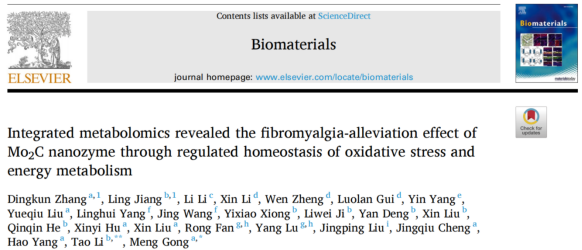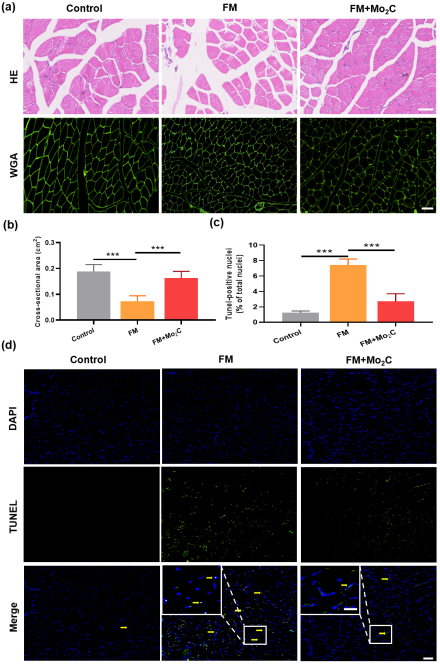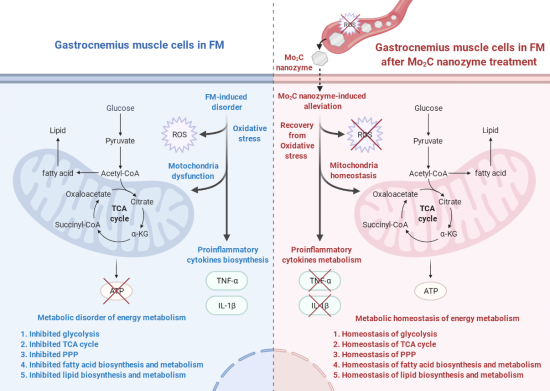In collaboration with Tao Li’s team from theLaboratory of Mitochondrial and Metabolism, Department of Anesthesiology, Meng Gong’s team from the Laboratory of Clinical Proteomics and Metabolomics, Institutes for Systems Genetics, Frontiers Science Center for Disease-related Molecular Network, West China Hospitalpublished an article entitled“Integrated Metabolomics Revealed the Fibromyalgia-Alleviation Effect of Mo2C Nanozyme Through Regulated Homeostasis of Oxidative Stress and Energy Metabolism”in Biomaterials (IF: 15.304) in July 2022. It is the first time to reveal the molecular mechanism of energy metabolism in the treatment of fibromyalgia with the help of comprehensive metabonomics technology.The study suggests that Mo2C nanozyme has the potential as a therapeutic drug for fibromyalgia, which provides a new idea for the clinical treatment of fibromyalgia.

Dingkun Zhang, an associate research fellow, and Dr. Ling Jiang are the first authors. The co corresponding authors are Meng Gong and Tao Li.
“Fibromyalgia (FM), the most common cause of chronic widespread musculoskeletal pain [1], is quite a common situation in the general public [2]. This syndrome was always associated with fatigue, anxiety, depression, sleep disturbance and cognitive dysfunctions.”(Introduction) FM affects almost 5% of the world's population, and most of them suffer from FM-originated symptoms. “Fibromyalgia (FM) --- lacks advanced therapeutic methodology and detailed bioinformation. However, acting as a newly developed and important transition metal carbide or carbonitride, the Mo2C nanozyme has provided a novel iatrotechnique with excellent bioactivity in a cell/animal model, which also exhibits potential prospects for future clinical applications. In addition, high-content and high-throughput integrated metabolomics (including aqueous metabolomics, lipidomics, and desorption electrospray ionization-mass spectrometry imaging) also specializes in qualitative and quantitative analysis of metabolic shifts at the molecular level. In this work, the FM-alleviation effect of Mo2C nanozyme was investigated through integrated metabolomics in a mouse model. An advanced platform combining gas chromatography-mass spectrometry, liquid chromatography-mass spectrometry and bioinformatics was utilized to study the variation in the mouse metabolome and lipidome. The results revealed that Mo2C treatment could effectively enhance energy metabolism-related biological events impaired by FM, leading to homeostasis of oxidative stress and energy metabolism toward the control levels. During this process, Mo2C facilitated the elimination of ROS in plasma and cells and the rehabilitation of mice from oxidative stress and mitochondrial dysfunction. It was believed that such an integrated metabolomics study on the FM-alleviation effect of Mo2C nanozyme could provide another excellent alternative to traditional Mo2C-based research with numerous pieces of bioinformation, further supporting research area innovation, material modification, and clinical application.” (Abstract)

Histological and pathological study on treatment of FM with Mo2C nanozyme

A Water Soluble Metabonomic Study of Mo2C Nanozyme in Treating FM

Molecular Mechanism of Mo2C Nanozyme in Treating FM
This study revealed the molecular mechanism of energy metabolism during the treatment of FM with Mo2C nanozyme by using metabonomics technology, which is an important attempt to expand the biomedical application of Mo2C nanozyme.
https://www.sciencedirect.com/science/article/abs/pii/S0142961222003180
